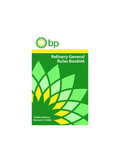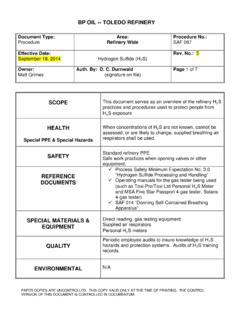Transcription of BP OIL -- TOLEDO REFINERY
1 BP OIL -- TOLEDO REFINERY . Document Type: Procedure No.: Procedure REFINERY Wide SAF 116. Effective Date: Revision No.: 5. March 31, 2017 Barricading of Hazardous Activities Owner: Authorized By: Christopher Conley Page 1 of 10. Dan Hurst (signature on file). This procedure describes the appropriate use of barricades to protect personnel from entering areas where hazardous activities or SCOPE conditions exist. Such activities include high pressure water blasting, unprotected overhead work, asbestos abatement, and countless other activities or hazards. This procedure applies to all work at the BP Husky TOLEDO REFINERY Site where barricades are needed to protect personnel and property. This procedure establishes guidelines for the use and installation of protective and warning barricades by BP employees and contractor organizations for communications of hazardous/potentially hazardous conditions or for communicating general hazards in areas of concern.
2 Any area where an occupational exposure limit will be exceeded HEALTH while performing work needs to be identified and barricaded to Special PPE & Special Hazards prevent unprotected and unauthorized entry. This procedure is to provide guidance to barricade potentially SAFETY hazards areas from unsafe conditions. OSHA Safety color code for marking physical hazards. OSHA (b) Safeguards for personnel protection. REFERENCE OSHA Accident prevention signs and tags. DOCUMENTS OSHA Specifications for Accident prevention signs and tags. SAF 082 Vehicle and Traffic Policy SAF 042 Working at Heights MAINT-E-033 Cranes and Lifting. Proper barricade tape or barricade materials necessary to warn of SPECIAL MATERIALS & hazards or protect area.
3 EQUIPMENT. QUALITY N/A. N/A. ENVIRONMENTAL. PAPER COPIES ARE UNCONTROLLED. THIS COPY VALID ONLY AT THE TIME OF PRINTING. THE CONTROLLED. VERSION IS IN DOCUMENTUM. Procedure No. SAF-116 Rev. OVERVIEW. The purpose of this procedure is to prevent injury and equipment damage by means of restricting access to hazardous areas and providing visual warnings of such hazards. Definitions Attendant: For short duration tasks, an attendant is a person assigned the sole duty to communicate hazard(s) in a specific area by using voice, whistle, flags, flashlight, or other methods. Attendents may be used in lieu or in conjunction with barricade tape to protect areas excluding lifting and hoisting as outlined later in this procedure Barricade: A physical device to prevent or limit access to an area where a hazard exists.
4 Permanent Barricades include those of permanent design (gates, roadblocks, metal protective barriers around manholes). Temporary Baricades (plastic or polypropylene tape, scaffold tubing, wooden structures ( sawhorses), portable flashing lights, and traffic cones/barrels). Barricade Tag: A visible tag is required on all temporary barricades designed to explain: the date(s) and time planned for barricade the hazards within the barricade the Company erecting the barricade and the contact person contact person's radio/telephone information Examples of barricade tags are illustrated in Appendix B. Barricade tags are a BP - Fisher Safety Store stock item. Barricade Tape: Ribbon or Flagging made from polypropylene or plastic Lifting Activity: Any activity that includes but not limited to the use of cranes, hoists, mechanical devices such as chain falls, come-alongs, well wheels and the manual use of rope, See MAINT-E-033.
5 4:1 Ratio: For every four feet high of elevation the barricade should be placed 1 foot out from the outer edge of the elevated work platform. Types of Tape The following barricade tape designs are approved for general use at the REFINERY : Danger Tape Red and black or Red and White (polypropylene/polyethylene tape/fabric) or Red is used where a hazard is known to exist. It is used to communicate an imminent hazard or dangerous condition that can result in death or serious injury. Unauthorized entry is prohibited. Examples include and are Page 2 of 10. PAPER COPIES ARE UNCONTROLLED. THIS COPY VALID ONLY AT THE TIME OF PRINTING. THE CONTROLLED. VERSION IS IN DOCUMENTUM. Procedure No. SAF-116 Rev. not limited to IDLH atmospheres, overhead work, scaffold erection, and confined spacesCaution Tape - Yellow and Black barricade tape which identifies areas which a potential hazard exists.
6 It is used to communicate a condition requiring individual CAUTION or awareness. Examples include and are not limited to protected overhead work, trenching, and tripping hazards Specific barricade tape designs are approved for use and may be utilized and observed on the site: Danger Asbestos tape identifies areas containing a potential asbestos hazard, such as exposed insulation or abatement activities. Only qualified workers, donned in appropriate PPE, will be allowed to enter this area Yellow and Magenta Caution Radiation Area tape: To be posted by qualified inspectors and accompanied by radiation warning signs at specific distances according to the type of radiation activity. Do not cross or alter this barricade tape.
7 Blue with white letters Energized Electrical Work . Refer to SAF 095, Working on or near Energized Electrical Equipment White with Red Letter DO NOT ENTER WITHOUT OPERATOR. PERMISSION. Refer to SAF 092, Removal of Non-essential Personnel during Periods of Increased Risk Planned Unit Startup and Shutdown Periods Responsibilities Operations Personnel: Establishes initial barricade boundaries for confined spaces, hazardous leaks or spills, and other operating conditions that are consistent with the hazards presented. Craft Foreman or Designee: Establishes safe boundaries for various maintenance or construction tasks in a unit or area including crane lifting and hoisting, welding, chemical handling, etc. Foremen are required to notify Operations, or establish joint approval, when boundaries are established.
8 Contractors: Be knowledgeable of the BP Barricade procedure;. recognize the hazards represented by the various barricade types, and erecting the proper barricades for the work and hazards they are creating. Contractors are required to notify Operations, or establish joint approval, when boundaries are established. All Employees: Be knowledgeable of the BP Barricade procedure, have thorough understanding of the various barricades types/colors/signage, recognize the hazards represented by each and ensure compliance with the procedure. Security and Emergency Response Personnel: Control pedestrian and vehicular traffic on roadways during emergency situations that allow safe/efficient egress for non-essential personnel and access for emergency vehicles.
9 Attendent: Communicate to others in the work area and stop others from entering a hazardous area. Page 3 of 10. PAPER COPIES ARE UNCONTROLLED. THIS COPY VALID ONLY AT THE TIME OF PRINTING. THE CONTROLLED. VERSION IS IN DOCUMENTUM. Procedure No. SAF-116 Rev. Barricade Placement Permanent barricades will be constructed of materials suitable to the task such as roadway guardrails, pre-cast concrete, structural steel, or other similar devices. For routine maintenance or construction tasks, barricades shall be erected and tagged prior to the actual beginning of work to avoid leaving an unprotected hazard. For construction or maintenance activities that will block traffic or close a road, see SAF-082 Vehicle and Traffic Safety Policy for specific requirements on road closures.
10 For lifting activities and when required by the risk assessment, barricades will be placed to control the line of fire hazard area using a 4:1 ratio. All groups working inside a barricade are responsible for maintaining the barricaded area's orderliness/housekeeping. Scaffold tubing, structural steel, steel plate and/or lumber utilized as a barricade, and functions as a guardrail or hole cover shall meet the minimum requirements described in HSSE Procedure SAF 042. Working at Heights, or OSHA Subpart D Walking/Working Surfaces. All temporary/hard barricades must have an access point for entering and exiting the barricaded area. Barricade tape used as a temporary barrier shall be red, yellow or a specialty color according to the nature of the hazard and be maintained between 32 inches and 48 inches high.


